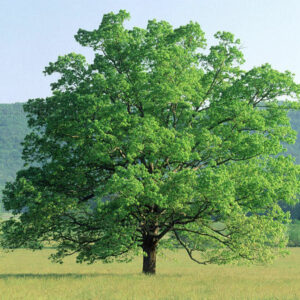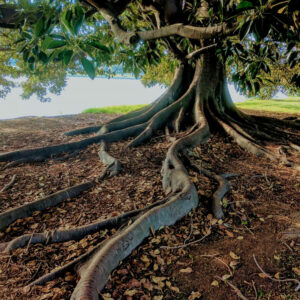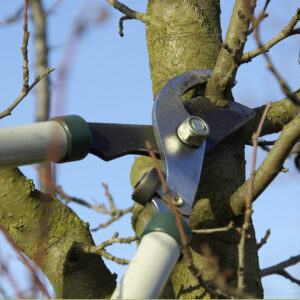About Trees
 1. The lungs of the world.
1. The lungs of the world.
Trees produce oxygen in exchange for carbon dioxide. A large tree puts out enough oxygen to sustain four people every day. It takes about 100 of them to capture and store one tonne (2,204 lbs.) of carbon dioxide in a year. Trees are most efficient at sequestering carbon in their younger years. The type planted will also have an effect on sequestration. Fast growing trees such as poplars are very good at this task.
2. Sewer seeking trees: fact or fiction?

The idea that tree roots maliciously seek out your sewage system an make any cracks is only an urban myth. What some roots will do is grow more vigorously in areas where they encounter moisture and nutrients (wouldn’t you?). If sewer pipes are old or have perforations or openings, then the roots will grow in that direction. A few cups of copper sulfate flushed through your toilet drains will kill hair roots and decompose larger roots without damaging the tree.
3. Deep roots.
 Trees with deep roots are the least likely to cozy up to your pipes and weeping tiles. These include bur oak, black walnut, common hackberry and some types of hickory. Ones that like dry conditions and so will avoid moisture-laden drains include beech, Black cherry, Black locust, European and Paper birch, Norway maple, many pines and spruces and Staghorn locust.
Trees with deep roots are the least likely to cozy up to your pipes and weeping tiles. These include bur oak, black walnut, common hackberry and some types of hickory. Ones that like dry conditions and so will avoid moisture-laden drains include beech, Black cherry, Black locust, European and Paper birch, Norway maple, many pines and spruces and Staghorn locust.
4. Fodder for feeder roots.
Most fine feeder tree roots exist within the top eight to 12 inches of soil. Use a method called vertical mulching to effectively fertilize a large tree. Measure out about three feet from the trunk. With an auger, drill two-inch diameter holes eight to 12 inches deep every 18 to 24 inches or so. Extend the pattern from three to 10 feet beyond the drip line of the tree. Alternately, dig a trench around it to the same depth. Back fill with peat moss, permeable materials and fertilizer. Then distribute the amount of fertilizer needed evenly between the holes. Fill the holes with coarse peat moss or fine gravel and water for a couple of hours.
5. To prune or not to prune roots.
A little root pruning will not harm your tree and will even stimulate new root growth. However, be careful not prune more than 30 per cent and don’t cut the anchor roots that extend on either side to give it stability. Sometimes a root pruning will shock a reluctant tree or shrub into flowering.
 6. The kindest cut.
6. The kindest cut.
When to prune how to prune, should I prune? These are all questions facing the new tree owner. The answer is simple. Healthy trees don’t need pruning unless they have damaged or diseased limbs. If you do have to remove a limb, cut it back to the swelling (the collar) that occurs just before the limb meets the trunk, leaving the collar in place to callus over and heal the wound. You do not need to paint the cut with anything. The second reason for pruning is cosmetic: sometimes people want to shape their trees for a variety of reasons. Finally, fruit trees are pruned in order to allow light to reach the centre branches and encourage the production of more fruit.
7. Plant a tree, reap a reward.
A healthy tree can increase the value of your home by up to 27 per cent. A damaged one, however, can decrease property value. Well-chosen and well-positioned trees can reduce heating costs by 15 percent in winter and cooling costs by as much as 50 per cent in summer.
8. Plant a tree for tomorrow.
Lilacs, elms, oaks and beeches can all live 200 to 300 years or more. Common firs and spruces can live as long as 800 years, and sequoia are well known both for their bulk and their great age. The champion long livers are the pines, one of which, Pinus longaeva, has been clocked at 4,900 years. Long-lived kinds generally grow slowly — some as slowly as one inch per century!
9. Plant a tree to clean up the environment.
Trees can clean up groundwater contamination through a process called phytoremediation. They can do this by changing the chemical composition of organic contaminants such as PCBs through interaction with bacteria at the root level. They can change the chemistry of heavy metals such as mercury which is then expired into the air through the leaves. Finally, they can take up contaminants and store them in their wood and in leaves. The recovery of heavy metals stored in this way is called phyto-extraction.
10. Can trees communicate with each other?
Some trees (elms come to mind) appear to exchange information and even nutrition through the network of mycorrhizae that populate their root systems. Mycorrhizae are fungi that have formed a symbiotic relationship with tree roots in order to obtain carbohydrates from the tree in exchange for water and mineral nutrients. Others (acacias) appear to be able to send either a chemical or an electrical message to fellows in their vicinity when they are under threat from a leaf-nibbling animal. And trees such as the black walnut certainly send chemical signals with a toxic substance called juglone that wards off competition from certain other plants.







